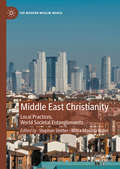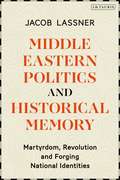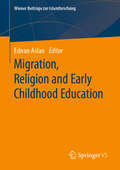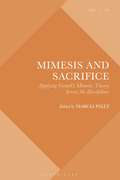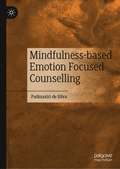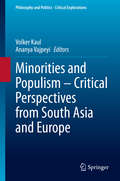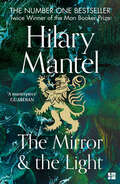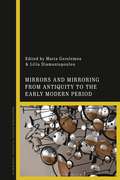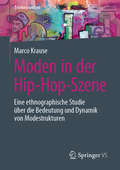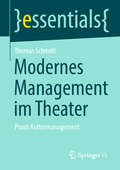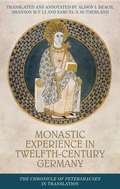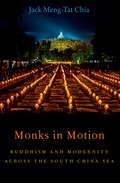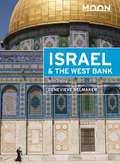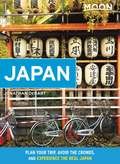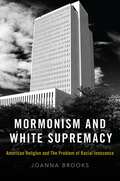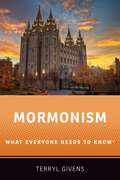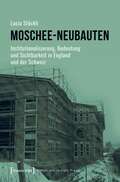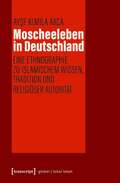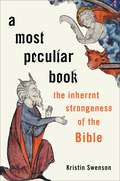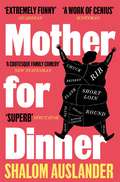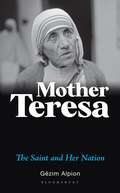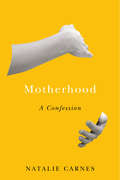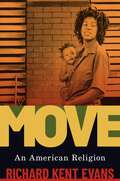- Table View
- List View
Middle East Christianity: Local Practices, World Societal Entanglements (The Modern Muslim World)
by Stephan Stetter Mitra Moussa NaboDrawing from theories of world society and from historical-sociological theories the book studies the past, present, and future of Middle East Christianity. It focuses on the interplay between local practices and post-colonial entanglements in global modernity. The chapters of this book engage, inspired by these theories, key empirical dynamics that affect Middle East Christianity. This includes a historical overview on the history of Christians in the region, the relationship between Islam and Christianity, as well as case studies on the Maronites in Lebanon, Egypt’s Copts, the role of Protestant missionaries in the 19th century, processes of individualization amongst Middle East Christians, as well as papal diplomacy in the region.
Middle Eastern Politics and Historical Memory: Martyrdom, Revolution, and Forging National Identities
by Jacob LassnerHow is the complex history of the ancient Near East and Islamic World brought to bear in contemporary political discourse?In this book, Medieval Near Eastern historian Jacob Lassner explores the resonance of ancient and medieval history in the political disputes that dominate the contemporary Middle East.From identification with ancient forbears as a method of legitimization and nation-building, to tracing the deep history of the concept of revolution in the Arab world, the author probes the historical foundations of modern conflicts in the region. A medievalist, the author takes the position that an appreciation of cultural history is essential to understanding the debate surrounding the Israel/Palestine conflict. In turn, the book identifies the misappropriation and misunderstanding of the past, deliberate or accidental, as key weapon in the ongoing conflict.
Migration, Religion and Early Childhood Education (Wiener Beiträge zur Islamforschung)
by Ednan AslanAlthough it is rarely given sufficient consideration in either scholarly or political debates, early childhood education plays a crucial role in the integration process of young immigrants in European countries, since it not only enables the children to be integrated into society, both linguistically and culturally, but it also provides their parents with the opportunity, through their children, to view the society more directly and to reflect on their own values in the encounter, or to potentially seek new orientations. The quality of young migrants’ educational achievements, which have repeatedly caused current political debates in European countries, should not be considered independently of the elementary education measures since they are very closely related.Prof. Dr. Ednan Aslan is Chair of Islamic Religious Education at the Institute for Islamic Theological Studies at the University of Vienna.
Mimesis and Sacrifice: Applying Girard's Mimetic Theory Across the Disciplines (Violence, Desire, and the Sacred)
by Marcia PallyCentral to identity, personal responsibility, economic systems, theology, and the political and military imaginaries, the practice of sacrifice has inspired, disturbed, and abused. Mimesis and Sacrifice brings together scholars from the humanities, military, business, and social sciences to examine the role that sacrifice plays in different present-day settings, from economics to gender relations. Inspired by Rene Girard's work, chapters explore (i) the extent to which the social character of human living makes us mimetic, (ii) whether mimesis necessarily leads to competitive aggression, (iii) whether aggression must be defused by aggressive sacrificial rituals-and whether all sacrifice has this aim, and (iv) the role of the “second lesson of the cross” (as Girard called it), the lesson of self-giving for others, in addressing present societal problems. By investigating sacrifice across this span of arenas and questions yet within one volume, Mimesis and Sacrifice presents a new appreciation of its influence and consequences in the world today, contributing not only to mimetic theory but to greater understanding of which societal arrangement enable us to live well together and what hobbles that goal.
Mindfulness-based Emotion Focused Counselling
by Padmasiri de SilvaThis book examines the use of Buddhist ideas, particularly mindfulness, to manage a broad spectrum of emotions and to address social and economic issues impacting the world, such as climate change. Beginning with a brief history of emotion studies, it highlights how recent developments in neuroscience and cognitive science have paved the way for exploring the utility of Buddhist concepts in addressing various psychological and social problems in the world. It profiles a wide range of emotions from Western and Buddhist perspectives including anger, sadness, depression, pride, and compassion, and analyses the integration of Buddhist ideas into modern clinical practice. Finally, the author demonstrates the utility of mindfulness in the regulation of emotions in various settings, including psychiatric clinics, schools, and businesses. Anchored in the Buddhist tradition this book this book provides a unique resource for students and scholars of counselling, psychotherapy, clinical psychology and philosophy.
Minorities and Populism – Critical Perspectives from South Asia and Europe (Philosophy and Politics - Critical Explorations #10)
by Ananya Vajpeyi Volker KaulThis volume assembles renowned scholars to address, for the first time, the relationship between minorities and populism in South Asia and Europe from a critical perspective. Despite the very different and to some extent opposite historical and political trajectories, there is today a convergence on nationalist affirmation and on majoritarian politics between South Asia and Europe. In India, the Hindu majority rebels against wide-ranging minority rights anchored in the Constitution. In Europe, the refugee crisis and Islamic radicalization bring to the forefront the postcolonial legacy. Despite all rhetoric, there are obvious dangers of majoritarianism. Populist parties are divisive, partisan, disregard minority rights, engage in lynching, social division, stigmatization and exclusion, turning minorities into second-class citizens. There is a profound structural connection between minorities and the current rise of populism in India and Europe. But there remains a deep perplexity and also anxiety: Does the presence of minorities necessarily have to trigger majoritarian policies? Are there no solutions to this dilemma? Many observers considered multicultural policies and affirmative action programs in India as a possible model for Europe to adopt in order to achieve greater integration. But eventually they seem to have failed. Why so? Are multiculturalism and the recognition of differences still options today? On the other hand, most scholars in India typically reject the European model of liberal democracy and secularism as impracticable in India and locate the reason for the current malaise in the west. But is liberal democracy really so bad in dealing with pluralism? This volume, collecting a selection of the Reset DOC Venice-Padua-Delhi dialogue series, is going to answer two fundamental questions. First, what precisely is the nexus between minorities and populism in South Asia and Europe? Starting from those case studies, the authors will also draw some general theoretical inferences about the nature of populism. Secondly, given the dangers of populism for minorities, the volume will look for the most adequate and feasible solutions.
The Mirror and the Light: A Novel (The Wolf Hall Trilogy #3)
by Hilary MantelThe long-awaited sequel to Wolf Hall and Bring Up the Bodies, the stunning conclusion to Hilary Mantel’s Man Booker Prize-winning Wolf Hall trilogy.
Mirrors and Mirroring from Antiquity to the Early Modern Period
by Maria Gerolemou Lilia DiamantopoulouThis volume examines mirrors and mirroring through a series of multidisciplinary essays, especially focusing on the intersection between technological and cultural dynamics of mirrors. The international scholars brought together here explore critical questions around the mirror as artefact and the phenomenon of mirroring. Beside the common visual registration of an action or inaction, in a two dimensional and reversed form, various types of mirrors often possess special abilities which can produce a distorted picture of reality, serving in this way illusion and falsehood. Part I looks at a selection of theory from ancient writers, demonstrating the concern to explore these same questions in antiquity. Part II considers the role reflections can play in forming ideas of gender and identity. Beyond the everyday, we see in Part III how oracular mirrors and magical mirrors reveal the invisible divine – prosthetics that allow us to look where the eye cannot reach. Finally, Part IV considers mirrors' roles in displaying the visible and invisible in antiquity and since.
Moden in der Hip-Hop-Szene: Eine ethnographische Studie über die Bedeutung und Dynamik von Modestrukturen (Erlebniswelten)
by Marco KrauseDiese Arbeit widmet sich dem Thema der szenespezifischen Moden. Der Kern dieser Forschungsarbeit besteht daraus, anhand einer ethnographischen Studie das szenespezifische Modephänomen im Kontext der Hip-Hop-Szene in seinen Strukturen abzubilden und dessen Facetten, Bedeutungen und Differenzierungen aufzudecken, um daran anknüpfend aufzuzeigen, welche Produkte beziehungsweise Produkteigenschaften die Szene-Mitglieder als Mode deklarieren und konsumieren und welchen Stellenwert dieses Phänomen innerhalb der Szene einnimmt. Die übergreifende Zielstellung bildet dabei die Generierung eines differenzierteren Betrachtungsansatzes des Modephänomens, welcher auf die Vergemeinschaftungsform der Hip-Hop-Szene bezogen ist und deren innere Strukturen und Facetten berücksichtigt.Der InhaltForschungsstand: Moden und Szenen • Forschungsstand: Hip-Hop-Szene • Forschungsdesign • Konsumrelevante Werte, Strukturen und Relationen in der Hip-Hop-Szene • Produktkonsum in der Hip-Hop-Szene • Moden in der Hip-Hop-SzeneDer AutorMarco Krause ist Soziologe mit Fokus auf den Bereich Konsumsoziologie und Consultant im Bereich Digital Intelligence.
Modernes Management im Theater: Praxis Kulturmanagement (essentials)
by Thomas SchmidtDie deutschen Theater befinden sich im Umbruch: In der Kritik stehen die veralteten Strukturen und die steile Hierarchie (Intendanten-Modell), die schlechten Arbeitsbedingungen und die Überproduktion. Das vorliegende Essential ist der Versuch, in knapper Form das Modell eines modernen Theatermanagements zu skizzieren, dass auf ethischen Maßstäben, Reformen, Diversität und Nachhaltigkeit beruht, mit dem Ziel das Theater ins Zentrum der Gesellschaft zu führen. Das Theater wird als künstlerisches Multi-Funktions-Unternehmen und Lernende Organisation begriffen, mit der zukünftigen Einbindung aller Stakeholder und der Integration ethischer und moderner Diskurse.
Momentos de quietud con Dios: 365 inspiraciones diarias
by Joyce MeyerStart your day with peaceful meditations, soulful inspirations, and encouraging Bible verses in this 365-day devotional from bestselling author Joyce Meyer -- and grow spiritually as you spend time with God.Life is busy and often uncertain, but you can live in the full peace of God with this easy-to-understand devotional designed to encourage you each day of the year. This includes a daily Bible verse followed by a devotional reading and power thought to meditate upon.With the constant demands and pressures, it can be hard to regularly take time to unplug and simply be with God. But Joyce's practical teaching format in Quiet Times with God will encourage you to discipline yourself so that you can receive the fullness of God's healing, revitalizing peace.
Monastic experience in twelfth-century Germany: The Chronicle of Petershausen in translation
by Alison I. Beach Shannong Li Samuel SutherlandMonastic experience in twelfth-century Germany provides a rare window on to monastery life in the tumultuous world of twelfth-century Swabia. From its founding in 992 through the great fire that ravaged it in 1159 and beyond, Petershausen weathered countless external attacks and internal divisions. Supra-regional clashes between emperors and popes played out at the most local level. Monks struggled against overreaching bishops. Reformers introduced new and unfamiliar customs. Tensions erupted into violence within the community. Through it all the anonymous chronicler struggled to find meaning amid conflict and forge connections to a shared past, enlivening his narrative with colorful anecdotes – sometimes amusing, sometimes disturbing. Translated into English for the first time, this fascinating text is an essential source for the lived experience of medieval monasticism.
Monastic experience in twelfth-century Germany: The Chronicle of Petershausen in translation
by Alison I. Beach Shannon M. Li Samuel SutherlandMonastic experience in twelfth-century Germany provides a rare window on to monastery life in the tumultuous world of twelfth-century Swabia. From its founding in 992 through the great fire that ravaged it in 1159 and beyond, Petershausen weathered countless external attacks and internal divisions. Supra-regional clashes between emperors and popes played out at the most local level. Monks struggled against overreaching bishops. Reformers introduced new and unfamiliar customs. Tensions erupted into violence within the community. Through it all the anonymous chronicler struggled to find meaning amid conflict and forge connections to a shared past, enlivening his narrative with colorful anecdotes – sometimes amusing, sometimes disturbing. Translated into English for the first time, this fascinating text is an essential source for the lived experience of medieval monasticism.
Monks in Motion: Buddhism and Modernity Across the South China Sea (AAR Academy Series)
by Jack Meng-Tat ChiaChinese Buddhists have never remained stationary. They have always been on the move. In Monks in Motion, Jack Meng-Tat Chia explores why Buddhist monks migrated from China to Southeast Asia, and how they participated in transregional Buddhist networks across the South China Sea. This book tells the story of three prominent monks Chuk Mor (1913-2002), Yen Pei (1917-1996), and Ashin Jinarakkhita (1923-2002) and examines the connected history of Buddhist communities in China and maritime Southeast Asia in the twentieth century. Monks in Motion is the first book to offer a history of what Chia terms "South China Sea Buddhism," referring to a Buddhism that emerged from a swirl of correspondence networks, forced exiles, voluntary visits, evangelizing missions, institution-building campaigns, and the organizational efforts of countless Chinese and Chinese diasporic Buddhist monks. Drawing on multilingual research conducted in Indonesia, Malaysia, Singapore, China, Hong Kong, and Taiwan, Chia challenges the conventional categories of "Chinese Buddhism" and "Southeast Asian Buddhism" by focusing on the lesser-known--yet no less significant--Chinese Buddhist communities of maritime Southeast Asia. By crossing the artificial spatial frontier between China and Southeast Asia, Monks in Motion breaks new ground, bringing Southeast Asia into the study of Chinese Buddhism and Chinese Buddhism into the study of Southeast Asia.
Moon Israel & the West Bank: With Petra (Travel Guide)
by Genevieve BelmakerAncient stories meet modern cities in this deeply significant region where the past is always present. Take the trip of a lifetime with Moon Israel & the West Bank. Inside you'll find:Flexible itineraries including a week in Jerusalem, 3 days in Tel Aviv, and a month exploring the region plus excursions to the West Bank, the Dead Sea, and PetraStrategic advice for foodies, pilgrims, beachgoers, archaeology buffs, and moreThe top sights and unique experiences: Visit the Church of the Holy Sepulchre or pay respects at the Western Wall, and stop at holy sites throughout Northern Israel and the West Bank. Feast on falafel, hummus, and shaksuka and haggle for antiques at a market in Jerusalem. Bike through Tel Aviv's charming Neve Tzedek neighborhood or relax at one of its beaches. Float in the Dead Sea, watch the sun set over the massive Negev craters, or stay overnight in a Bedouin tent encampmentLocal insight: Jerusalem journalist Genevieve Belmaker shares the history and culture of her beloved home Full-color, vibrant photos throughoutDetailed maps for exploring on your own, and useful tips on border crossings and checkpointsThorough background information on the landscape, history, government, and cultureHandy tools including Hebrew and Arabic phrasebooks, health and safety tips, customs and conduct, and information for LGBTQ, female, and senior travelers, families with children, and travelers with disabilitiesFocused coverage of Jerusalem, Tel Aviv, Haifa, the North Coast, the Galilee and the Golan Heights, the West Bank, Eilat and the Negev, and Petra, JordanExperience the best of Israel and the West Bank with Moon's practical advice and insider tips.
Moon Japan: Plan Your Trip, Avoid the Crowds, and Experience the Real Japan (Travel Guide)
by Jonathan DeHartFrom the world's busiest intersection to the most serene hot springs, modernity and tradition mingle in Japan. Experience the natural wonder and rich culture of a country unlike any other with Moon Japan. Inside you'll find:Flexible itineraries including a two week 'Best of Japan' and a week in and around TokyoStrategic advice for spiritual seekers, anime fans, foodies, fashionistas, hikers, and moreThe top sights and unique experiences: Wander the shrines and temples of Ueno-koen park and stop in Tokyo National Museum for world-renowned Japanese art. Learn about samurai heritage in Sanmachi Suji or zazen meditation at the Buddhist temples of Kyoto, and get an unforgettable lesson in 20th century history at Hiroshima Peace Memorial Park Outdoor adventures: Hike the trails of Mt. Fuji or the river-filled valley of Kamikochi and relax in a communal onsen hot spring. Ski or snowboard at a world-class resort, surf in the Pacific off the coast of Shikoku, or dive along the coral reefs of OkinawaThe best local flavors: Feast on ramen or an elaborate spread of sushi, sample fresh seafood at the world's largest fish market in Tokyo, and drink your way through the famed beer scene in SapporoHonest insight from American expat and longtime Tokyo local Jonathan DeHartFull-color, vibrant photos throughoutDetailed maps and useful tips for navigating public transportation Focused coverage of Tokyo, Mt. Fuji, Kanazawa, Kyoto, Kansai, Hiroshima and Miyajima, Okinawa, Tohoku and Hokkaido, Shikoku and Kyushu, and moreThorough background information on the landscape, wildlife, history, government, and cultureHandy tools including health and safety tips, customs and conduct, and information for LGBTQ, female, and senior travelers, as well as families and travelers with disabilitiesWith Moon's practical advice and insider tips, you can experience the best of Japan.Exploring more of Asia? Check out Moon Vietnam.
Mormonism and White Supremacy: American Religion and The Problem of Racial Innocence
by Joanna BrooksTo this day, churchgoing Mormons report that they hear from their fellow congregants in Sunday meetings that African-Americans are the accursed descendants of Cain whose spirits--due to their lack of spiritual mettle in a premortal existence--were destined to come to earth with a "curse" of black skin. This claim can be made in many Mormon Sunday Schools without fear of contradiction. You are more likely to encounter opposition if you argue that the ban on the ordination of Black Mormons was a product of human racism. Like most difficult subjects in Mormon history and practice, says Joanna Brooks, the priesthood and temple ban on Blacks has been managed carefully in LDS institutional settings with a combination of avoidance, denial, selective truth-telling, and determined silence. As America begins to come to terms with the costs of white privilege to Black lives, this book urges a soul-searching examination of the role American Christianity has played in sustaining everyday white supremacy by assuring white people of their innocence. In Mormonism and White Supremacy, Joanna Brooks offers an unflinching look at her own people's history and culture and finds in them lessons that will hit home for every scholar of American religion and person of faith.
MORMONISM WENK C: What Everyone Needs to Know® (What Everyone Needs To KnowRG)
by Terryl GivensMormonism, or the Church of Jesus Christ of Latter-day Saints, is America's most successful-and most misunderstood-home grown religion. The church today boasts more than 15 million members worldwide, a remarkable feat in the face of increasing secularity. The growing presence of Mormonism shows no signs of abating, as the makeup of its membership becomes progressively diverse. The heightened contemporary relevance and increasingly global membership of the Church solidifies Mormonism as a religious group much deserving of awareness. Covering the origins, history, and modern challenges of the church, Mormonism: What Everyone Needs to Know offers readers a brief, authoritative guide to one of the fastest growing faith groups of the twenty-first century in a reader-friendly format, providing answers to questions such as: What circumstances gave rise to the birth of Mormonism? Why was Utah chosen as a place of refuge? Do you have to believe the Book of Mormon to be a Latter-day Saint? Why do women not hold the priesthood? How wealthy is the church and how much are top leaders paid? Written by a believer and the premier scholar of the Latter-day Saints faith, this remarkably readable introduction provides a sympathetic but unstinting account of one of the few religious traditions to maintain its vitality and growth in an era of widespread disaffiliation.
Moschee-Neubauten: Institutionalisierung, Bedeutung und Sichtbarkeit in England und der Schweiz (Kultur und soziale Praxis)
by Lucia StöckliIn den letzten Jahrzehnten sind in Europa vermehrt Moschee-Neubauten entstanden. Lucia Stöcklis religionswissenschaftliche Studie geht der Geschichte der Etablierung der Moschee-Neubauten in England und der Schweiz nach und beleuchtet ihre Bedeutung für die Muslime. Anhand bestehender und in Planung befindlicher Bauprojekte arbeitet sie gemeinsame Strukturen sowie nationale Kontexte heraus und untersucht Themen wie die Entwicklung eines multifunktionalen Zentrums, die Rolle der Frau in den Moschee-Neubauten sowie den Stellenwert der Sichtbarkeit dieser Bauten für die Muslime.
Moscheeleben in Deutschland: Eine Ethnographie zu Islamischem Wissen, Tradition und religiöser Autorität (Globaler lokaler Islam)
by Ayse Almila AkcaWelches religiöse Wissen und welche Praktiken sind in deutschen Moscheen vorzufinden? Wie legitimieren Muslim*innen islamisches Wissen als gültig bzw. ungültig und wer autorisiert dieses Wissen? Ayse Almila Akca bietet mit ihrer ethnographischen Studie tiefe Einblicke in das Moscheeleben in Deutschland und gibt spannende Antworten auf diese und weitere Fragen. Sie hinterfragt gängige Vorstellungen und analysiert religiöse Autorität, Geschlechterverhältnisse und innerislamische Kritik in deutschen Moscheen auf Basis ihrer langjährigen und intensiven Feldforschungen. Damit leistet sie einen wichtigen Beitrag, um die Entwicklungen im islamischen Feld in Deutschland besser zu verstehen.
A Most Peculiar Book: The Inherent Strangeness of the Bible
by Kristin SwensonThe Bible, we are constantly reminded, is the best-selling book of all time. It is read with intense devotion by hundreds of millions of people, stands as authoritative for Judaism and Christianity, and informs and affects the politics and lives of the religious and non-religious around the world. But how well do we really know it? The Bible is so familiar, so ubiquitous that we have begun to take our knowledge of it for granted. The Bible many of us think we know is a pale imitation of the real thing. In A Most Peculiar Book, Kristin Swenson addresses the dirty little secret of biblical studies that the Bible is a weird book. It is full of surprises and contradictions, unexplained impossibilities, intriguing supernatural creatures, and heroes doing horrible deeds. It does not provide a simple worldview: what "the Bible says" on a given topic is multi-faceted, sometimes even contradictory. Yet, Swenson argues, we have a tendency to reduce the complexities of the Bible to aphorisms, bumper stickers, and slogans. Swenson helps readers look at the text with fresh eyes. A collection of ancient stories and poetry written by multiple authors, held together by the tenuous string of tradition, the Bible often undermines our modern assumptions. And is all the more marvelous and powerful for it. Rather than dismiss the Bible as an outlandish or irrelevant relic of antiquity, Swenson leans into the messiness full-throttle. Making ample room for discomfort, wonder, and weirdness, A Most Peculiar Book guides readers through a Bible that will feel, to many, brand new.
Mother for Dinner: A Novel
by Shalom AuslanderSeventh Seltzer has done everything he can to break from the traditions of the past, but in his overbearing, narcissistic mother’s last moments, she whispers in his ear the two words he always knew she would: ‘Eat me’.This is not unusual, as the Seltzers are Cannibal-Americans, a once proud and thriving ethnic group, but for Seventh, it raises some serious questions. Of practical concern, she’s six-foot-two and weighs over thirty stone – even divided up between Seventh and his eleven brothers, that's a lot of red meat. Plus Second keeps kosher, Ninth is vegan and Sixth is dead. To make matters worse, even if he can wrangle his brothers together for a feast, the Can-Am people have assimilated, and the only living Cannibal who knows how to perform the ancient ritual is their Uncle Ishmael, a far from reliable guide.Beyond the practical, Seventh struggles with the sense of guilt and responsibility he feels – to his mother, to his people and to his unique cultural heritage. His mother always taught him he was a link in a chain, stretching back centuries. But he’s getting tired of chains.Shalom Auslander's Mother for Dinner is an outrageously tasty comedy about identity and inheritance, the things we owe our families and the things we owe ourselves.
Mother Teresa: The Saint and Her Nation
by Gëzim AlpionA personality of Mother Teresa's calibre and global reach does not come about by chance. To provide a well-rounded portrait of this influential figure, this book approaches her in the context of her familial background and ethnic, cultural and spiritual milieus. Her life and work are explored in the light of newly-discovered information about her family, the Albanian nation's spiritual tradition before and after the advent of Christianity, and the impact of the Vatican and other influential powers on her people since the early Middle Ages. Focusing on her traumas, ordeals and achievements as a private individual and a public missionary, and her complex spirituality, this book contends that Mother Teresa's life and her nation's history, especially her countrymen's relationship with Roman Catholicism, are interconnected. Unravelling this interconnectedness is essential to understanding how this modern spiritual and humanitarian icon has come to epitomise her ancient nation's cultural and spiritual DNA.
Motherhood: A Confession (Encountering Traditions)
by Natalie CarnesA meditation on the conversions, betrayals, and divine revelations of motherhood. What if Augustine's Confessions had been written not by a man, but by a mother? How might her tales of desire, temptation, and transformation differ from his? In this memoir, Natalie Carnes describes giving birth to a daughter and beginning a story of conversion strikingly unlike Augustine's—even as his journey becomes a surprising companion to her own. The challenges Carnes recounts will be familiar to many parents. She wonders what and how much she should ask her daughter to suffer in resisting racism, patriarchy, and injustice. She wrestles with an impulse to compel her child to flourish, and reflects on what this desire reveals about human freedom. She negotiates the conflicting demands of a religiously divided home, a working motherhood, and a variety of social expectations, and traces the hopes and anxieties such negotiations expose. The demands of motherhood continually open for her new modes of reflection about deep Christian commitments and age-old human questions. Addressing first her child and then her God, Carnes narrates how a child she once held within her body grows increasingly separate, provoking painful but generative change. Having given birth, she finds that she herself is reborn.
MOVE: An American Religion
by Richard Kent EvansWhat is a religion? That is the question that Richard Kent Evans attempts to answer in this book. He does so through the story of MOVE, a little-known group with a fascinating story. MOVE emerged in Philadelphia in the early 1970s. It was a small, mostly African American group devoted to the teachings of John Africa. In 1985, the Philadelphia Police Department -- working in concert with federal and state law enforcement -- attacked a home that "MOVE people" as they preferred to be known, shared in West Philadelphia. Hundreds of police officers and firefighters laid siege to the building using tear gas, ten thousand rounds of ammunition, and improvised explosives. Most infamously, a police officer riding in a helicopter dropped a bomb containing C-4 explosives, which he had acquired from the FBI, onto the roof of the MOVE house. The bomb started a fire, which officials allowed to spread in hopes of chasing the MOVE people out of the house. Police officers fired upon those who tried to escape the flames. Eleven MOVE people died in the attack, including John Africa. Five of those who died were children. In this book, Richard Kent Evans tells the story of MOVE -- a story that has been virtually lost outside of Philadelphia. What was MOVE? Many MOVE members thought of themselves as belonging to a religion, and they sought legal recognition. But to others, including other religious groups like the Quakers and, more importantly, the courts, MOVE was anything but a religion. Evans dives deep into how we decide what constitutes a genuine religious tradition, and the enormous consequences of that decision.
